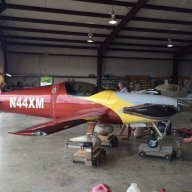Hi everyone,
Thanks for your encouragement. When I brought my project home in August from my co-builders workshop where we had put in around 200 hours work over 2.5 weeks, working on the fuselage, I just had to sit it in my driveway to admire it. I was hoping to mount the tailplane for the photo session, but I was leaving to return O/S the next day and didn't have time to do this so I had to take the photos without the tailplane being mounted. I played with one of the fuselage photos on Photoshop to come up with the canopy arrangement (on my avatar) and I have to admit to regularly bringing up this photo to admire the sleek lines of the aircraft. It really does look fast just sitting there. I picture it with the nosegear retracted and with the wheel pants on, with its' small wing and I just can't wait to get this baby in the air!
The engines I will be using are the JetBeetle H150R which have 150lbf thrust each. You can read about them at their website www.jetbeetle.com . I hope to be the agent for these engines in Oz and with a 70/90/150 lbf range, there may be something there for other peoples projects (picture a twin jet Drifter...). The H150R really chews the gas but my aircraft is aimed at going flying for 20-30 minutes and land with a big smile on your face. It is not a practical aircraft to go anywhere in but that said, I intend to have a molded tank that can be strapped to the rear seat and be quick connected to the fuselage tank to give an additional 50% extra fuel for ferry purposes. If the aircraft is climbed straight to FL180 (pilot on cannular oxy), then it should have a range of 250+ miles so I will be able to take it to the fly-ins, just without a passenger. It is intended to be a pure VFR fun aircraft to fly. It will be fitted with a Dynon D10A EFIS.
In my dreams, it will be finished mid-2012. Reality may be somewhat different.
If the thing actually works, I have the molds for everything and may consider putting out kits if there is enough interest. I expect the kits would run to about $40,000 with engines being around $27000 plus radio/instruments, so maybe $75000 all up for your own twin-jet. That doesn't sound too bad when stacked up against a more expensive Jabiru... Time will tell... I have to get my Komet going first and test it thoroughly.
Cheers to everyone.
Dave





